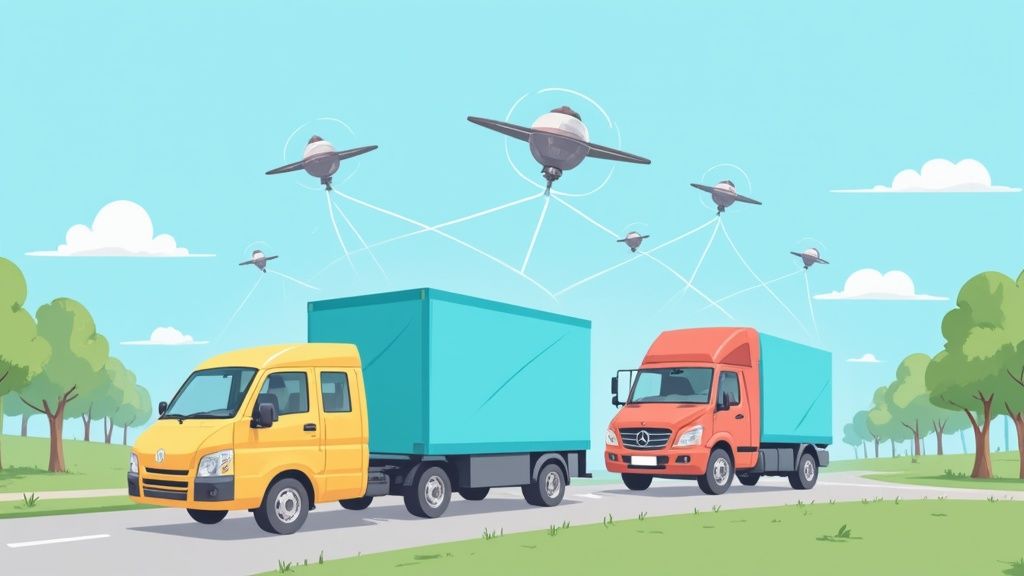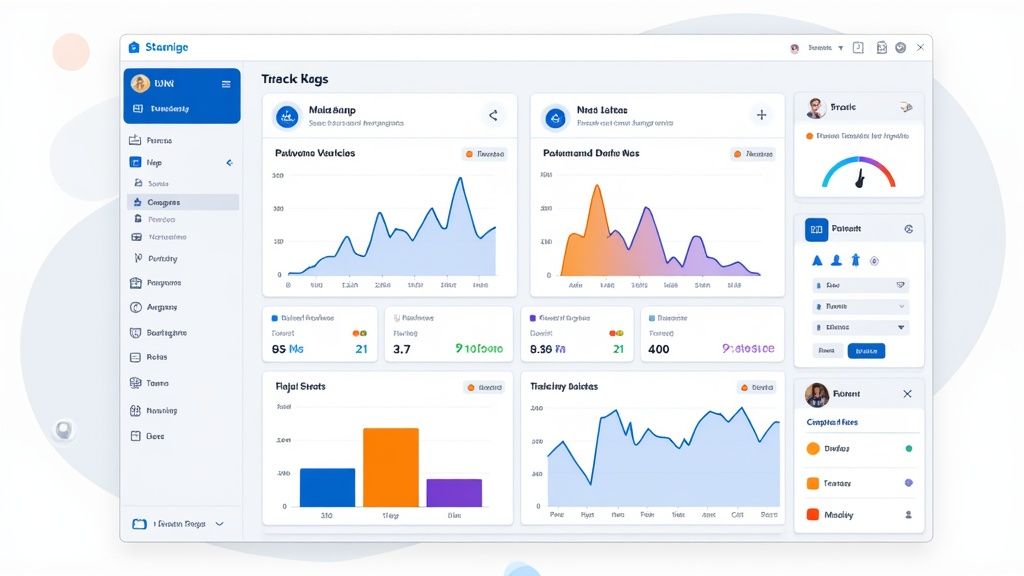
GPS Tracking for Fleets: Proven Strategies to Revolutionize Fleet Performance
The Evolution of Modern Fleet Tracking

GPS tracking has come a long way since its military origins, becoming essential for modern fleet operations. What started as a specialized navigation tool is now a core technology that gives fleet managers real-time visibility into their operations. Current data shows this shift clearly - 70% of successful fleets now consider GPS tracking a must-have tool for their daily operations.
From TRANSIT to GPS: A Technological Leap
The story begins with TRANSIT, a satellite navigation system created by the US Navy in the 1950s to track submarine locations. This early system laid the groundwork for today’s global navigation satellite system (GNSS). The first GPS satellites went into orbit in the late 1970s, and by 1994, the full 24-satellite GPS network was up and running. This development marked a key shift from specialized military use to widespread commercial applications, especially in fleet management.
The Dawn of Commercial GPS and the Rise of the Internet
In 1996, President Clinton’s directive made GPS commercially available, opening new possibilities for businesses. This timing perfectly matched the growth of the internet, creating ideal conditions for fleet tracking innovation. Fleet managers could now see their vehicles’ locations in real-time through web platforms. This improved visibility had real benefits - companies could plan better routes, watch driver behavior more closely, and run their operations more efficiently. For example, delivery companies could give customers more precise arrival times and track packages throughout their journey.
Connecting the Dots: M2M Communication and the Cloud
The mid-2000s brought two major advances: machine-to-machine (M2M) communication and cloud computing. M2M technology allowed vehicles to automatically share data with central management systems, giving fleet managers deeper insights into performance. Cloud systems made it possible to store and process large amounts of data affordably, helping businesses of all sizes use advanced GPS tracking. These combined technologies provided more accurate data that managers could access quickly, helping them make better decisions and respond faster to changes.
The Modern Landscape: IoT, AI, and Beyond
Today’s GPS fleet tracking goes far beyond simple location monitoring. The system now includes Internet of Things (IoT) sensors, artificial intelligence, and detailed analytics. IoT sensors collect many types of information - from engine status and fuel use to driving patterns and environmental conditions. AI systems then analyze this data to find patterns and suggest improvements. This means fleet managers can spot potential problems early, create fuel-efficient routes, and improve driver safety. Cloud platforms help connect this tracking data with other business systems, making operations smoother. As these technologies keep improving, GPS tracking will continue to offer new ways for fleets to work better, operate more safely, and increase profits.
Measuring What Matters: Core Benefits That Drive ROI

GPS fleet tracking has become essential for companies looking to improve their operations and bottom line. Beyond simple location tracking, this technology provides detailed data that helps businesses make smarter decisions and achieve measurable results. By examining key metrics and benefits, companies can clearly see the real financial impact of implementing GPS tracking systems.
Fuel Efficiency and Cost Reduction
Smart fuel management stands out as one of the most impactful benefits of GPS fleet tracking. Fleet managers can spot wasteful practices like extended idling, speeding, and inefficient routes by monitoring vehicle data in real-time. For instance, when a vehicle idles too long, instant alerts allow managers to address the issue through driver coaching. The results speak for themselves - businesses typically see a 10% drop in fuel costs after implementing GPS tracking. With today’s unpredictable fuel prices, these savings can significantly boost profitability, especially for larger fleets.
Optimized Routing and Labor Management
Effective route planning through GPS tracking helps companies complete more jobs while reducing costs. By choosing the most efficient routes and dispatching the closest vehicles to each job, businesses minimize both drive time and miles traveled. The system also simplifies payroll by automatically tracking work hours, eliminating manual timekeeping errors. These routing and labor improvements typically lead to an 11% reduction in labor expenses, showing how GPS tracking creates real cost savings through smarter operations.
Enhanced Safety and Reduced Accident Costs
GPS tracking plays a vital role in promoting safer driving and preventing accidents. The system monitors key safety indicators like speeding, hard braking, and other risky behaviors, allowing managers to identify drivers who need additional training. When accidents do occur, GPS data provides objective information for insurance claims and investigations. Companies that use GPS tracking to improve fleet safety often reduce accident-related costs by 17%, demonstrating clear financial benefits alongside increased road safety.
Measuring ROI and Driving Continuous Improvement
To get the most value from GPS tracking, successful fleet managers focus on tracking the right performance metrics. Key indicators like fuel use, mileage, idle time, driver behavior patterns, and accident frequency help measure the system’s impact. However, it’s important to look beyond basic location tracking and analyze the full range of available data. Setting clear goals, regularly reviewing metrics, and adjusting strategies based on the findings helps ensure GPS tracking continues delivering strong returns over time. This systematic approach to measurement and improvement helps companies maximize their investment in fleet tracking technology.
Building Your Real-Time Fleet Management Ecosystem

A well-designed GPS tracking system goes beyond simple location tracking - it needs to work smoothly with your other business tools to give you a complete view of fleet operations. When GPS data connects with dispatch software, you can automatically assign jobs and adjust routes based on real-time traffic. This means drivers always take the most efficient path to their destinations, saving time and fuel.
Seamless Integration: Avoiding Compatibility Headaches
Smart planning prevents common integration problems that many fleet managers face. One frequent issue is when important data gets stuck in separate systems and can’t be shared easily between them. The solution is to choose GPS tracking platforms with open APIs that work well with your existing business software - from customer management to maintenance tracking to payroll systems. When all these pieces work together, you can turn raw tracking data into useful insights. Make sure to pick a system that can grow with your business and adapt to new technology. This forward planning will prevent costly changes down the road.
Prioritizing Features for Maximum Impact
Not every GPS tracking feature will give you equal benefits. The most successful fleets focus on core capabilities that directly improve their key metrics. Essential features include real-time location updates, automated alerts when vehicles enter or exit certain areas, driver safety monitoring, and detailed performance reports. By concentrating on these high-impact tools, fleet managers can effectively tackle fuel costs, safety records, and overall efficiency. The ability to adjust settings for your specific needs is often the most valuable feature.
Evaluating Provider Claims and Promises
When choosing a GPS tracking provider, look past marketing materials to find real proof of results. Ask for case studies from similar businesses and speak directly with current customers about their experiences. This gives you an honest picture of what the provider can deliver and how well they support their clients. Pay special attention to how they protect your data - fleet information is a key business asset that needs strong security measures.
Practical Workarounds for Technology Limitations
While GPS tracking offers powerful benefits, it’s important to understand its limits. Tall buildings and thick tree coverage can sometimes affect GPS signal accuracy. Good fleet managers develop practical solutions for these situations, like using cell tower signals as backup location data when GPS accuracy drops. By planning ahead for these challenges and having backup systems ready, you ensure your tracking system remains reliable. This practical approach helps you get full value from your GPS tracking investment.
Implementation Strategies That Actually Work

Installing GPS tracking is just the first step - success requires careful planning, clear performance targets, and proper driver training. Without considering these key elements, companies often face pushback from drivers, collect inaccurate data, and fail to see meaningful returns. A thoughtful implementation approach helps ensure the technology delivers real value.
Overcoming Resistance to Tracking Technology
Drivers’ concerns about GPS tracking present one of the biggest challenges to successful adoption. Many worry it will lead to micromanagement or unfair evaluations. The key is open communication about how the technology helps everyone. For instance, GPS data can protect drivers by providing evidence in accidents or disputes. Getting drivers involved early in the implementation and actively addressing their feedback builds trust and support. This collaborative mindset makes a huge difference in acceptance.
Effective Driver Training and Benchmarking
Once GPS devices are installed, thorough training becomes essential. Drivers need practical guidance on using the technology and understanding how the company will use the data. Training should cover device operation, report interpretation, and data privacy policies. Clear performance targets tied to business goals, like reducing idle time or improving delivery timing, help measure progress. Regular feedback based on these benchmarks keeps drivers engaged and motivated to improve.
Accelerating Your Path to Success: A Step-by-Step Approach
Start small when implementing GPS tracking - test with a subset of vehicles before expanding fleet-wide. This lets you work out technical issues and address concerns before a full rollout. Give the process enough time, especially for installation, training and early data analysis. Moving too quickly often creates frustration that undermines long-term success.
Identifying Warning Signs and Making Adjustments
Keep a close eye on performance metrics and make changes as needed. High idle times may signal the need for additional driver coaching or route changes. Stay flexible as fleet needs evolve - this might mean adding new GPS features, connecting with other systems, or updating benchmarks. Regular monitoring helps catch issues early. A basic 3-month review checklist includes:
- Review driver feedback on the system
- Analyze key performance indicators (KPIs) like fuel consumption and mileage
- Assess the accuracy and reliability of the data collected
- Identify any technical issues or areas for improvement
With careful planning, proactive problem-solving, and ongoing performance tracking, fleets can fully capture the efficiency, safety and cost benefits that GPS technology offers. The key is taking a strategic, systematic approach focused on driver buy-in and measurable results.
Creating a Culture of Safety Through Smart Tracking
Safety is one of the most compelling reasons to implement GPS tracking for commercial fleets. Organizations that thoughtfully use tracking technology see an average 38% drop in accidents while also improving driver satisfaction and retention. The key is using tracking capabilities strategically to build a proactive safety culture, rather than just monitoring basic metrics.
Identifying Risk Patterns Through Data Analysis
Modern GPS tracking systems capture detailed data that reveals important safety trends. Fleet managers can analyze specific behaviors like speeding incidents, hard braking, quick acceleration, and extended idling periods to spot potential risks. Instead of generic safety rules, this enables targeted solutions. For instance, if tracking shows frequent speeding on a particular route segment, managers can investigate whether unrealistic scheduling or recurring traffic patterns are contributing factors that need to be addressed systematically.
Developing Effective Training Programs Based on Real-World Data
The rich data from GPS tracking allows fleet managers to create focused, relevant training. Rather than generic safety courses, they can tailor programs to address specific improvement areas for each driver or route. This personalized coaching demonstrates a commitment to driver development while ensuring training addresses actual needs. The tracking system also provides clear metrics to measure progress and identify where additional support may help.
Fostering a Positive Safety Culture Through Communication and Recognition
Building a strong safety culture requires more than rules and monitoring - it needs open dialogue and driver engagement. When fleet managers share overall safety trends, celebrate improvements, and recognize safe driving excellence, it creates shared ownership of safety goals. Programs like “Driver of the Month” awards based on GPS tracking data can motivate consistent safe practices. This collaborative approach helps safety become part of the company’s values rather than just a set of requirements.
Measuring Safety Improvements and Demonstrating ROI
To show the business value of GPS tracking investments, fleet managers should track key safety indicators including accident rates, near-miss incidents, insurance costs, and accident-related maintenance expenses. By connecting these metrics to specific safety initiatives enabled by tracking technology, managers can quantify the positive impact on both safety and finances. This data-driven evaluation helps justify continued investment in safety tools while reinforcing the importance of safety culture across the organization.
Preparing Your Fleet for Tomorrow’s Technology
Managing a modern fleet requires staying ahead of new GPS tracking and related technologies. Success comes from understanding both current solutions and the tools that will define fleet operations in the coming years.
Emerging Technologies Reshaping Fleet Management
GPS tracking systems are becoming smarter through artificial intelligence and machine learning. These technologies analyze massive datasets to uncover patterns and provide insights that humans couldn’t find alone. For instance, AI systems can predict when vehicles need maintenance by analyzing performance data and operating conditions, helping prevent breakdowns before they occur. This leads to better routing, proactive maintenance scheduling, and even automated dispatch - all of which boost efficiency and cut costs.
The growth of Internet of Things sensors is also expanding fleet data capabilities. Advanced sensors now track detailed information about vehicle health, driver behavior, and environmental factors. Fleet managers can see their entire operation in real-time, spotting issues early and making data-driven decisions. These insights translate directly into safer operations, lower fuel usage, and smoother logistics.
Integrating Autonomous Vehicles into Your Fleet Strategy
Self-driving vehicles are moving from concept to reality. While fully autonomous fleets are still developing, companies need to prepare now for their eventual adoption. This means assessing infrastructure needs, understanding regulations, and planning for workforce changes. Getting ahead of these challenges and opportunities will position your fleet for success as autonomous technology matures.
Evaluating New Technologies and Ensuring Long-Term Value
With many emerging technologies to choose from, identifying truly valuable solutions takes careful evaluation. Create clear criteria tied to your business goals to assess each new tool. Consider the full costs including implementation, training staff, and ongoing support. This structured approach helps separate genuinely useful advances from temporary trends.
Strategic Planning for Future Success
Staying competitive requires actively planning for future technology needs. Build a long-term technology roadmap aligned with your broader business strategy. Regularly review new developments and adjust plans accordingly. For example, run small pilot programs to test promising technologies before full rollout. This controlled testing helps identify potential issues early while limiting risk.
Building an adaptable, future-ready fleet means embracing continuous improvement and new capabilities. With a strategic approach to emerging technologies, you can keep your operations efficient, safe and profitable for years to come. Ready to modernize your fleet management? Explore Auto Service Logger, a digital platform that simplifies maintenance records and centralizes vehicle data. Visit https://autoservicelogger.com/ to learn more.